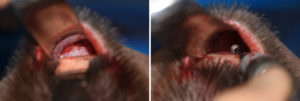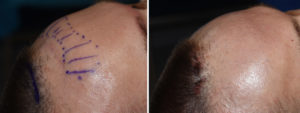Background: The forehead is formed by the large frontal bone which occupies all skull real estate from the coronal suture down to the orbits. It is comprised of two segments, one oriented vertically (squamous segment) and one oriented horizontally. (orbital segment) It is easy to see that the brow bones on the lower end of the forehead come from the orbital segment while the smooth and more convex forehead above it comes from the squamous segment.
While the forehead is usually fairly smooth it is well known to have paired prominences which are most commonly called forehead eminences or horns. Given that the frontal bone develops from two separate ossification centers, one for each half, it is easy to presume that such bony horns arise from them. Before birth a midline suture connects these two halfs (metopic suture) but this closes over quickly after birth if not before in most people.
These small upper forehead bumps can occur as paired prominences or they can be connected by a linear line of bone giving them a ‘dumbbell’ appearance. These raised forehead areas are often not very large (high) and are generally in the 3mms or so range in height. While not usually particularly high they nonetheless stay out in certain lighting and can be a source of aesthetic distraction. In my experience these foerehasd prominences occur predominantly in males which may present unique challenges for reduction of them.
Case Study: This male was bothered by his upper forehead prominences which had a horizontal linear connection between them. In certain lighting and at certain angles they were more noticeable to him.



Forehead prominences in my experience are much more common in men. Whether this is due to a hormonal influence and the development of thicker bone is only speculative. I have treated them in women but not as frequently. With female hairstyles perhaps they are more obscured. In men with a good frontal hairline, such as in this patient, scalp incisional access above it can be done for their reduction. In men with much higher hairline or no hairline at all, the only option is a direct incision over it which would only be aesthetically acceptable if there was a horizontal wrinkle line close by.
Case Highlights:
1) The forehead is typically a smooth surface so any prominences are aesthetically noticeable.
2) Forehead horns are bilateral upper forehead prominences that may be connected. (dumbbell deformity)
3) Forehead contouring through burring reduction of the upper forehead prominences can be done through a limited scalp incision placed behind the hairline.
Dr. Barry Eppley
Indianapolis, Indiana




